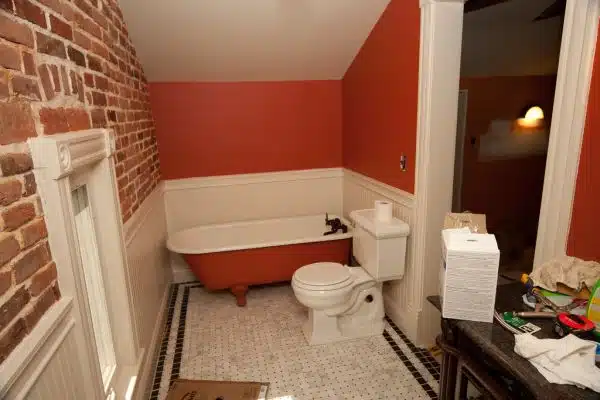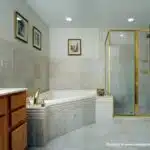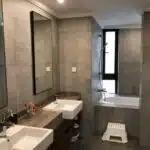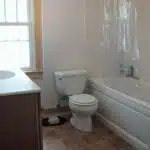As a homeowner, it is essential to have a functional and well-designed space in your house. Adding an attic bathroom is one way to maximize the functionality of your property while increasing its value. However, installing an attic bathroom can be quite challenging, especially if you lack the proper knowledge and expertise.
In this article, we will take you through the process of installing an attic bathroom. We will provide you with the necessary information and tips that will help you achieve your goal of creating a beautiful and functional space in your home. Whether you’re a DIY enthusiast or seeking professional assistance from licensed plumbers, this article aims to equip you with the skills needed to accomplish your project successfully.
Assessing Your Attic Space
Before installing an attic bathroom, it is important to assess the space available. Measuring the area and identifying structural requirements are crucial in determining if the attic can accommodate a bathroom. The first step is to measure the size of the attic and determine which areas are suitable for installing a bathroom. Consider the ceiling height, as this will affect the placement of fixtures and ventilation.
Structural requirements are also essential when assessing your attic space. Check with your local building codes to ensure that your attic meets all necessary structural requirements. This includes proper framing, support beams, and trusses. If you have any doubts about the structural integrity of your home or whether your attic can handle additional weight, it is best to consult with a licensed contractor or engineer.
By measuring space and identifying structural requirements, you can determine if your attic is suitable for a bathroom installation. Proper planning at this stage will save you time and money in the long run by avoiding potential issues during construction. In the next section, we will discuss how to plan your bathroom layout based on the information gathered from assessing your attic space.
Planning Your Bathroom Layout
Did you know that adding a bathroom to your attic can increase the value of your home by up to 20%? But before you start hammering away, it’s crucial to plan out the layout for optimal space utilization. In this section, we will discuss some design considerations and tips for optimizing your attic bathroom layout.
Design considerations are essential when planning your attic bathroom. First, consider where your plumbing connections are located. You’ll want to place your fixtures close to the existing pipes to minimize the need for additional plumbing work. Additionally, think about natural light sources to make the room feel more spacious and welcoming. Skylights or windows can provide natural light and ventilation while adding aesthetic value to the space.
Space optimization is critical in an attic bathroom due to its limited square footage. Consider installing a shower instead of a bathtub, as it takes up less space and allows for more room for other fixtures. A pedestal sink or wall-mounted vanity can save floor space while providing ample storage options. Installing corner shelves or cabinets can also maximize vertical space while keeping clutter off the floor.
With these design considerations and space-saving tips in mind, you’re on your way to creating an efficient layout for your attic bathroom. In the next section, we’ll discuss choosing the right fixtures to complete your dream bathroom renovation seamlessly.
Choosing The Right Fixtures
When installing an attic bathroom, one must consider the type of toilet they would like, as well as the sink and faucet to be used. Additionally, it is essential to plan for ventilation, lighting, mirrors, and tiles. Furthermore, it is important to determine the type of flooring and paint, as well as the storage and plumbing needs. Additionally, accessories, drains, and piping must be considered when installing an attic bathroom. Finally, the design of the bathroom should reflect the homeowner’s taste and style.
Toilet
When it comes to choosing the right fixtures for an attic bathroom, one of the most important considerations is the toilet. Proper toilet placement is crucial for ensuring that your bathroom space is as functional and efficient as possible. When planning where to install your toilet, be sure to consider factors such as access to plumbing lines, proximity to other fixtures, and ease of use.
Another key factor to keep in mind when selecting a toilet for your attic bathroom is flushing options. There are a variety of different flushing systems available, each with their own pros and cons. Some popular options include gravity flush toilets, pressure-assisted toilets, and dual-flush toilets. Be sure to do your research and choose a flushing system that meets your needs in terms of performance, efficiency, and ease of maintenance.
Ultimately, when it comes to installing an attic bathroom, choosing the right toilet is essential for creating a functional and comfortable space. By taking into account factors such as toilet placement and flushing options, you can ensure that you select a fixture that works well within your overall design scheme while also providing optimal performance and reliability. With careful planning and attention to detail, you can create the perfect bathroom retreat in your attic space.
Sink
When it comes to choosing the right fixtures for your attic bathroom, selecting the right sink is crucial. Sink placement is an important consideration when designing your bathroom layout, as it can impact the functionality and efficiency of your space. Be sure to choose a location that provides easy access to plumbing lines and allows for comfortable use. Additionally, consider the style of sink that best fits your design scheme and meets your needs in terms of size and functionality.
Once you have determined the optimal location for your sink, it’s time to select a faucet that complements both its design and functionality. There are a wide range of faucet options available on the market today, ranging from traditional two-handle models to sleek single-handle designs with touchless technology. When selecting a faucet, be sure to consider factors such as ease of use, durability, and water efficiency. By choosing a high-quality faucet that meets all of your needs, you can ensure that your attic bathroom remains functional and stylish for years to come.
Ultimately, selecting the right sink and faucet for your attic bathroom requires careful planning and consideration. By taking into account factors such as sink placement and faucet options, you can create a functional and attractive space that meets all of your needs while also providing optimal performance and reliability. With attention to detail and a commitment to quality, you can create an attic bathroom retreat that truly enhances the value of your home.
Faucet
When it comes to designing an attic bathroom, choosing the right fixtures is crucial. The sink and faucet are two of the most important components that require careful consideration. Faucet styles have come a long way from traditional two-handle models to sleek single-handle designs with touchless technology. When selecting a faucet, one must consider factors such as ease of use, durability, and water efficiency.
There are several types of faucets available in the market, including wall-mounted, deck-mounted, and floor-mounted faucets. Wall-mounted faucets create more counter space and are ideal for small bathrooms, whereas deck-mounted faucets offer more installation flexibility. Floor-mounted faucets can add a unique touch to your bathroom design but require additional plumbing work. When installing a faucet, it’s essential to follow manufacturer instructions and hire a licensed plumber if necessary.
To ensure optimal performance and longevity of your faucet, consider investing in high-quality materials such as brass or stainless steel. Additionally, look for features such as ceramic disc valves that prevent leaks and provide smooth operation. Water-saving aerators can also help reduce water usage without sacrificing performance. By carefully selecting a faucet that meets all of your needs and following proper installation techniques, you can enjoy a functional and stylish bathroom for years to come.
Selecting Materials For Your Bathroom
When it comes to selecting materials for your attic bathroom, you must first consider the type of flooring you want. Bathroom flooring should be durable, moisture-resistant and slip-resistant. Popular options include ceramic or porcelain tile, vinyl sheet or tile, and luxury vinyl plank. Ceramic or porcelain tile is a classic choice that is both durable and easy to clean. Vinyl is an affordable option that comes in a variety of colors and patterns. Luxury vinyl plank provides a more upscale look with the added benefit of being waterproof.
Once you have chosen your flooring, it’s time to think about the overall decor of your attic bathroom. Since attics can often be smaller spaces, choosing light-colored walls and decor can help make the room feel more open and spacious. Consider adding decorative touches like shelving units or artwork to give the space some personality. You may also want to add some greenery by placing potted plants on a windowsill or shelf.
To evoke an emotional response in your audience, here are some key considerations when selecting materials for your attic bathroom:
- Choose materials that will withstand moisture and humidity to ensure longevity.
- Opt for timeless finishes that won’t go out of style over trendy options.
- Prioritize functionality over aesthetics to create a space that is both beautiful and practical.
- Don’t forget about safety – select slip-resistant flooring and install grab bars as needed.
Moving forward, determining plumbing requirements will be essential in installing your attic bathroom properly.
Determining Plumbing Requirements
As you move forward with your attic bathroom installation, it’s important to consider the plumbing requirements that will be needed to make it fully functional. One key aspect of this is pipe placement, which involves determining where the pipes will need to run in order to connect the various components of the bathroom. This can be a complex process that requires careful planning and attention to detail.
Another important factor to consider when installing an attic bathroom is water pressure requirements. Depending on the size and layout of your bathroom, you may need to install specialized equipment such as a booster pump or pressure regulator in order to ensure that water flows at the appropriate rate and volume for your needs. This is an essential step in creating a comfortable and convenient space that meets all of your needs.
In addition to these plumbing considerations, there are also a number of electrical considerations that must be taken into account when installing an attic bathroom. These may include wiring for lights, power outlets, and other fixtures, as well as ensuring that all wiring is up to code and installed safely and securely. By taking these factors into account and working with an experienced contractor or plumber, you can create a beautiful and functional bathroom that meets all of your needs while also being safe and reliable for years to come.
Electrical Considerations
When it comes to installing an attic bathroom, one of the most important considerations is electrical safety. Improper wiring can lead to serious hazards such as electrocution or fire, so it’s essential to ensure that all electrical work is up to code and done by a licensed professional. This includes everything from running wires and installing outlets to connecting lighting fixtures and exhaust fans.
To ensure wiring safety in your attic bathroom, there are several key things to keep in mind. First and foremost, all electrical work must be done in compliance with local building codes and regulations. This may include obtaining permits or inspections before you can begin work. Additionally, it’s crucial that all wiring is properly grounded and installed using appropriate materials and techniques.
Another important consideration when installing an attic bathroom is ventilation. Adequate ventilation is essential for preventing moisture buildup and mold growth, which can cause health problems as well as damage to your home’s structure over time. Some key factors to consider when planning your bathroom ventilation system include the size of the room, the number of occupants, and the type of fixtures you plan to install.
- Make sure your exhaust fan is properly sized for your bathroom space.
- Consider installing a timer switch or humidity sensor to help regulate airflow.
- Choose a venting route that allows for maximum air exchange without compromising insulation or structural integrity.
- Install proper ductwork and piping to ensure efficient ventilation.
- Regularly clean and maintain your exhaust fan and vents to prevent blockages.
With these wiring safety tips in mind, you can feel confident that your new attic bathroom will not only look great but also function safely for years to come. In our subsequent section on installing insulation and ventilation, we’ll dive deeper into some specific techniques for keeping your space comfortable while minimizing energy costs.
Installing Insulation And Ventilation
Insulation is an essential aspect of creating a comfortable and efficient attic bathroom. When selecting insulation types, it is important to consider the R-value, which measures the insulation’s ability to resist heat flow. The higher the R-value, the more effective the insulation will be. Common types of insulation for attics include fiberglass batts, blown-in cellulose, and spray foam.
Ventilation is also vital in an attic bathroom to prevent moisture buildup and mold growth. There are several ventilation options available, including exhaust fans, roof vents, and soffit vents. An exhaust fan can help remove moisture from the air while also reducing odors. Roof vents and soffit vents can promote air circulation and prevent condensation buildup.
Properly insulating and ventilating your attic bathroom will not only make it more comfortable but can also save you money on energy bills in the long run. By choosing the right insulation type with a sufficient R-value and installing proper ventilation systems like exhaust fans or roof vents, you can ensure that your new bathroom will be both functional and efficient.
With insulation and ventilation taken care of, it’s time to move on to framing your bathroom properly. This step involves ensuring that walls are level, installing plumbing fixtures correctly, and reinforcing structural elements where necessary. A licensed plumber or home improvement expert can provide guidance on this process if needed, ensuring that your bathroom is safe, sturdy, and built to last for years to come.
Framing Your Bathroom
After insulating and ventilating your attic space, the next step in installing an attic bathroom is framing. Framing techniques are crucial to ensure that the bathroom walls and ceiling are secure and structurally sound. When framing your bathroom, it’s important to consider structural considerations such as load-bearing walls and weight distribution.
Before starting the framing process, determine the location of your shower or tub. This will help you plan the layout of your bathroom and ensure that there is enough space for all necessary fixtures. Once you have determined the location, use appropriate framing techniques to create a sturdy base for your shower or tub.
When framing around load-bearing walls, it’s important to consult with a professional to ensure that you are not compromising the structural integrity of your home. Additionally, make sure to properly distribute weight on any new floor joists or beams added during the installation process. By taking these structural considerations into account during the framing process, you can ensure that your attic bathroom is safe and secure for years to come.
Next up: Installing Your Shower or Tub.
Installing Your Shower Or Tub
After completing the necessary plumbing and framing work, the next step is to install your shower enclosure or tub. For an attic bathroom, it is essential to choose a shower or tub that fits within the limited space and provides sufficient headroom. A shower enclosure with a low profile base and sliding doors can be a great option for small spaces.
When it comes to flooring options for your attic bathroom, waterproofing is crucial. Opt for materials such as ceramic tiles, vinyl planks or sheeting, or engineered wood that have been specifically designed for high-moisture areas. These materials provide excellent durability and resistance against water damage that may occur in an attic bathroom. It’s important to note that carpeting should never be used as a flooring material in bathrooms.
Incorporating waterproof flooring options into your bathroom design ensures that any water spills or splashes will not cause damage to the subfloor and structure of your home. Once you have completed this step, you are ready to move on to adding plumbing fixtures such as faucets, toilets, and sinks.
Adding Plumbing Fixtures
Plumbing fixtures are essential components of an attic bathroom. Adding these fixtures comes with its own unique set of challenges, but with the right approach, it can be accomplished effectively. The first step is to identify the ventilation options available for your bathroom because proper ventilation is critical in preventing moisture buildup and mold growth.
Plumbing challenges may arise during the process of adding fixtures to your attic bathroom, so it’s crucial to work with a licensed plumber who can help you navigate any obstacles that come up. One of the most significant challenges is providing adequate water pressure to your fixtures. This can be solved by installing a pressure booster or a larger diameter pipe to ensure sufficient water pressure throughout your bathroom.
When selecting plumbing fixtures for your attic bathroom, consider their functionality and aesthetic appeal. Opt for low-flow models that are energy-efficient and environmentally friendly. Additionally, choose fixtures that complement the overall design of your bathroom while serving their intended purpose effectively. With these considerations in mind, you’ll create a functional and appealing space that adds value to your home.
As you move forward in adding plumbing fixtures to your attic bathroom, it’s important to also plan for installing lighting and electrical outlets on time. These features go hand-in-hand with plumbing fixtures, and planning ahead will save you time and money in the long run. By ensuring proper lighting and convenient access to electrical outlets, you’ll create an inviting and comfortable space that meets all of your needs.
Installing Lighting And Electrical Outlets
Installing lighting and electrical outlets in an attic bathroom requires careful planning and execution. Proper lighting placement is essential for creating a well-lit and functional space. Determine the location of your vanity, shower, and toilet to determine the type of lighting that will be needed. For example, recessed lighting is ideal for overhead lighting, while sconces can be used to provide additional task lighting around the vanity area.
Outlet positioning is also crucial in an attic bathroom installation project. Code requirements dictate that outlets must be installed at specific distances from water sources for safety reasons. In general, outlets should be located at least three feet away from any wet areas such as showers or sinks. It’s important to consider how many outlets you’ll need based on the size of your bathroom and the number of appliances you plan to use.
When installing lighting and electrical outlets in an attic bathroom, it’s best to consult with a licensed electrician. They have the knowledge and expertise necessary to ensure that all wiring and fixtures are installed correctly and up to code. With proper planning and execution, your attic bathroom can become a comfortable and functional space that adds value to your home.
As you move forward with your attic bathroom installation project, it’s time to start thinking about flooring options. The right flooring can help tie together the look of your new space while also providing practical benefits like slip resistance and water resistance. Let’s explore some popular flooring options for attic bathrooms in our next section.
Flooring Options
As you plan to install an attic bathroom, choosing the right flooring option is crucial. The flooring material should be durable, water-resistant, and slip-resistant. Additionally, it should match your style preferences and budget. Two common options for attic bathroom floors are tile and vinyl.
Tile has long been a popular choice for bathroom floors due to its durability and water resistance. It also comes in various colors, shapes, and sizes, allowing for customization of your bathroom’s look. However, tile can be more expensive than other options and requires professional installation. Additionally, if not installed correctly or sealed properly, moisture can seep through grout lines and cause damage to the subfloor.
On the other hand, vinyl is an affordable flooring option that is easy to install and maintain. It is water-resistant and slip-resistant, making it ideal for bathrooms. Vinyl also comes in various styles such as sheet or tile form that mimic the look of natural stone or wood. However, vinyl may not be as durable as tile and can easily scratch or dent over time.
When selecting your flooring material for your attic bathroom renovation project consider these waterproofing options:
- Waterproof membrane – This option involves applying a waterproof membrane beneath the floor surface to prevent water from penetrating the subfloor.
- Sealant – Applying a sealant on top of the floor surface after installation prevents moisture from seeping into gaps between tiles or planks.
- Grout sealer – Sealing grout lines with a specialized product helps prevent moisture from reaching the subfloor while also preventing mold growth.
Now that you have considered different flooring materials available for your attic bathroom renovation project along with waterproofing options let’s step into wall finishes that will accentuate the beauty of your new space!
Wall Finishes
After considering the best flooring options for your attic bathroom, it’s time to move on to the next step of the renovation process: choosing wall finishes. When selecting a color scheme for your bathroom walls, it’s important to keep in mind that lighter colors will create a sense of spaciousness and brightness, while darker colors can make the room feel smaller and more enclosed. Ultimately, you’ll want to choose a color that complements your flooring choice and creates a cohesive look throughout the space.
In terms of tile options for your bathroom walls, there are many different materials and styles to choose from. Ceramic and porcelain tiles are popular choices due to their durability and water resistance properties. Glass tiles are also an option if you’re looking to add some visual interest or texture to your walls. When selecting tiles, consider factors such as the size of the tiles, grout color, and whether or not you want them to be glossy or matte.
Overall, choosing colors and tile options for your bathroom walls is an important part of creating a functional and visually appealing space. By keeping in mind factors such as lighting, flooring choices, and personal style preferences, you can select wall finishes that perfectly complement your new attic bathroom. In the next section, we’ll discuss how to maximize storage space in your newly renovated bathroom without sacrificing style or functionality.
Adding Storage Options
Imagine your attic bathroom is now complete, and you are ready to start using it. However, you notice that the space feels cramped, and there’s not enough room to store all of your toiletries and towels. Don’t worry; there are plenty of creative solutions for maximizing space in your attic bathroom.
One option is to install shelving above the toilet or sink area. This will provide additional storage space without taking up any floor space, which is essential in a small bathroom. You can also consider installing a medicine cabinet or mirrored cabinet with adjustable shelves inside.
Another solution for maximizing space in your attic bathroom is to use the walls for storage. You can hang hooks or racks for towels and robes, install a floating shelf above the bathtub or shower for soap and shampoo bottles, or even add a recessed shelf in the wall for storing extra toilet paper.
By incorporating these creative solutions into your attic bathroom design, you’ll be able to maximize every inch of available space while still maintaining a stylish and functional aesthetic. With proper storage options in place, you’ll be able to enjoy your new bathroom without feeling cluttered or overwhelmed by belongings.
As you finalize the storage options in your attic bathroom, don’t forget about the final touches and decoration! Adding personal touches such as artwork, plants, or decorative baskets can make all the difference in creating a cozy and inviting atmosphere. In the next section, we will explore some ideas for adding those finishing touches to complete your dream attic bathroom design.
Final Touches And Decoration
After completing the major installation of an attic bathroom, it’s time to focus on the final touches and decoration. One crucial aspect is determining the color scheme that will complement the room’s design and create a relaxing ambiance. Neutral shades such as gray, beige, and white are popular choices for bathrooms because they offer a clean look while allowing for pops of color with accessories.
When selecting bathroom accessories, it’s essential to choose items that not only match the color scheme but also serve practical purposes. A towel rack or hooks are necessary additions to any bathroom, while soap dispensers and toothbrush holders not only keep items organized but also add a decorative touch. Choosing accessories made from durable materials like metal or ceramic ensures they will last longer in a high-moisture environment.
Incorporating personal touches into the bathroom adds character and makes it feel like a cozy retreat. Consider adding artwork or wall decor that reflects your personality or interests. Adding plants or greenery can also provide a natural touch and improve air quality. With attention to detail, your attic bathroom can become a functional and stylish addition to your home.
Conclusion
Installing an attic bathroom can be a challenging yet rewarding project that can add significant value to your home. When planning your bathroom layout, it is crucial to assess your attic space and determine the best location for your fixtures. Choosing the right fixtures is also essential, as they need to fit within the limited space while providing the necessary functionality.
Selecting appropriate materials for your bathroom is equally important. Certain materials are better suited for attic spaces due to their durability and resistance to moisture and temperature changes. Determining plumbing requirements is crucial, as it will impact the location of your sink, toilet, and shower or bathtub.
When it comes to flooring options, consider using materials that can withstand high humidity levels and potential water damage. Similarly, select wall finishes that are resistant to moisture and easy to clean. Adding storage options such as built-in cabinets or shelves can help maximize your space while keeping clutter at bay.
Finally, adding final touches such as lighting fixtures and decorative accents can enhance the overall aesthetic of your new bathroom. As a licensed plumber or home improvement expert, we recommend hiring a professional contractor who specializes in attic bathroom installations if you’re unsure about any aspect of this project. With careful planning and attention to detail, you can create a beautiful and functional attic bathroom that adds value to your home while meeting all of your needs.
Image Credits
- “attic bathroom” by MissChatter (featured)





























